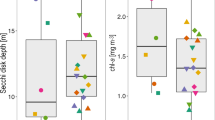Abstract
Distribution and development of phytoplankton were studied in the deep and large Lake Päijänne from mid-winter until the disappearance of ice. Diatoms were an important part of the phytoplankton assemblage and, with cryptophytes and chrysophytes, made up 50–80% of the phytoplankton biomass. In mid-winter, chlorophyll a and phytoplankton biomass were uniformly distributed over the whole water column down to a depth of 90 m. Thus, most of the phytoplankton was in virtual darkness and there was negligible growth. Only motile cryptophytes were concentrated in the layers below the ice and were rare in deep water. After the disappearance of snow, convection developed, but at first cryptophytes were able to resist mixing. When convection turned from penetrative to predominantly horizontal, all phytoplankton were generally uniformly distributed in the water column. In spite of the full under-ice overturn with low average availability of light, the phytoplankton biomass doubled in April. The growth of cryptophytes was higher than that of diatoms, suggesting that motile species gained an advantage by being able to maintain themselves in the upper, illuminated layers. The results show that knowledge of the basic physical framework is essential for interpretation of under-ice phytoplankton results.






Similar content being viewed by others
References
Bengtsson L (1996) Mixing in ice-covered lakes. Hydrobiologia 322:91–97
Bolsenga SJ, Vanderploeg HA (1992) Estimating photosynthetically available radiation into open and ice-covered freshwater lakes from surface characteristics; a high transmittance case study. Hydrobiologia 243–244:95–104
Bondarenko NA, Guselnikova NE, Logacheva NF (1996) Spatial distribution of phytoplankton in Lake Baikal, Spring 1991. Freshw Biol 35:517–523
Cloern JE, Alpine AE, Cole BE, Heller T (1992) Seasonal changes in the spatial distribution of phytoplankton in small, temperate-zone lakes. J Plankton Res 14:1017–1024
EN 15204 (2006) Water quality. Guidance standard on the enumeration of phytoplankton using inverted microscope (Utermöhl technique)
Granberg K (1973) The eutrophication and pollution of Lake Päijänne, Central Finland. Ann Bot Fenn 10:267–308
Granberg K (1992) Changes in water quality in Lake Päijänne following decrease of effluent load from the pulp and paper industry in 1969–1989. Hydrobiologia 243–244:343–395
Jewson DH, Granin NG, Zhdarnov AA, Gorbunova LA, Bondarenko NA, RYu Gnatovsky (2008) Resting stages and ecology of the planktonic diatom Aulacoseira skvortzowii in Lake Baikal. Limnol Oceanogr 53:1125–1136
Jewson DH, Granin NG, Zhdanov AA, Gnatovsky RYu (2009) Effect of snow depth on under-ice irradiance and growth of Aulacoseira baicalensis in Lake Baikal. Aquat Ecol
Jones H (1997) A classification of mixotrophic protists based on their behaviour. Freshw Biol 37:35–43
Jones RI (2000) Mixotrophy in planktonic protists: an overview. Freshw Biol 45:219–226
Kelley DE (1997) Convection in ice-covered lakes: effects on algal suspension. J Plankton Res 19:1859–1880
Matthews PC, Heaney SI (1987) Solar heating and its influence on mixing in ice-covered lakes. Freshw Biol 18:135–149
McKnight D, Howes BL, Taylor CD, Goehringer DD (2000) Phytoplankton dynamics in a stably stratified Antarctic lake during winter darkness. J Phycol 36:852–861
Rengefors K, Legrand C (2001) Toxicity in Peridinium aciculiferum—an adaptive strategy to outcompete other winter phytoplankton? Limnol Oceanogr 46:1990–1997
Richardson TL, Gibson CE, Heaney SI (2000) Temperature, growth and seasonal succession of phytoplankton in lake Baikal, Siberia. Freshw Biol 44:431–440
Roberts EC, Laybourn-Parry J (1999) Mixotrophic cryptophytes and their predators in the dry valley lakes of Antarctica. Freshw Biol 41:737–746
Rodhe W (1955) Can plankton production proceed during winter darkness in subarctic lakes? Verh Int Verein Limnol 12:117–122
Tuchman NC, Schollett MA, Rier ST, Geddes P (2006) Differential heterotrophic utilization of organic compounds by diatoms and bacteria under light and dark conditions. Hydrobiologia 561:167–177
Tulonen T, Kankaala P, Ojala A, Arvola L (1994) Factors controlling production of phytoplankton and bacteria under ice in a humic, boreal lake. J Plankton Res 16:1411–1432
Acknowledgments
This study was supported by Academy of Finland (grant 104409). We thank particularly D. Jewson for kind help in improving the manuscript.
Author information
Authors and Affiliations
Corresponding author
Rights and permissions
About this article
Cite this article
Kiili, M., Pulkkanen, M. & Salonen, K. Distribution and development of under-ice phytoplankton in 90-m deep water column of Lake Päijänne (Finland) during spring convection. Aquat Ecol 43, 707–713 (2009). https://doi.org/10.1007/s10452-009-9262-7
Received:
Accepted:
Published:
Issue Date:
DOI: https://doi.org/10.1007/s10452-009-9262-7




